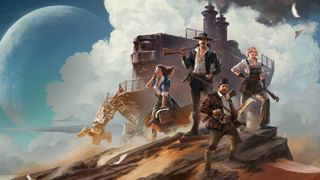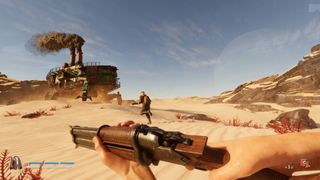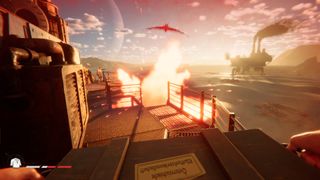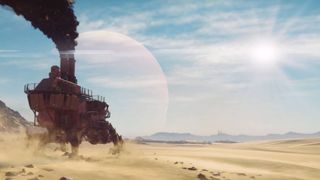In Sand, you'll explore the wastes of a dead planet colonized by the Austro-Hungarian empire
Hologryph is immortalizing the history of Western Ukraine—while developing its game in a war-stricken country.
Look, plenty of games have wacky premises, but "dystopian open-world survival set in an alternate future where the Austro-Hungarian empire discovered interplanetary travel on the eve of World War 1" is the most bizarre setting I've seen in quite some time. Yet that's the lore foundation for the upcoming multiplayer title Sand from Ukrainian developers Hologryph and publishers tinyBuild.
The team is still very early in development, but Sand is already shaping up to be an unusual multiplayer looter-survival game that not only uses the familiar trope of scavengers searching for scraps on a doomed planet but will show off the historic architecture of a part of the world that I don't think has ever really been explored in games.

"Our game is set in an alternate history where at the beginning of the 19th century, the Austro-Hungarian Empire discovered a new resource that allowed them to colonize space," Hologryph co-founder and game director of Sand Serhiy Grinets says. "They started to colonize nearby solar systems, and the events of the game take place at the beginning of the 20th century, near the beginning of the first world war."
In Sand, you hail from the real-world Galicia region of the former Austro-Hungarian Empire. Its people now operate as scavengers on the planet Sofia, a world doomed by an unknown cataclysm after a failed colonization attempt. You’ll journey across the desolate sandy seafloor of the planet on hulking customizable tramplers, large ship-like vessels that you can build from orbit that allow traversal of the wastes, searching for islands to loot of treasures and upgrades.
"Our main two influences were Sea of Thieves for that feeling of traveling the oceans on ships with your friends, and Rust for the thrill of danger and that cool feeling of starting with nothing and increasing your power by either carefully upgrading on your own or taking your spear and killing a guy to steal his rifle, then raiding a base of five guys," Grinets says. "It might be stupid, but it’s possible, and you feel like an action hero like Rambo."

The war has somehow just been added to our routine.
Sergii Grinets, game director
The team at Hologryph is still toying with a few ideas regarding the core gameplay loop of Sand, but currently, it’s looking at combining the extraction style gameplay of Escape from Tarkov or Dark and Darker with the more persistent world of Rust.
"We have a few different ideas, but one we like right now is that players can build their trampler in orbit, equip it with provisions, weapons, ammo, and fuel, then drop to the surface," Grinets says. "Unlike typical extraction games with 30 or so minute sessions, you'll connect to a server with a much longer lifecycle. Resources will respawn, and you'll explore to find loot before trying to return to a drop zone to extract it." Other than environmental hazards, your main danger will be other players, who you can encounter on loot-filled islands or while traversing the sandy wastes, desperately trying to escape with your haul.
The biggest gaming news, reviews and hardware deals
Keep up to date with the most important stories and the best deals, as picked by the PC Gamer team.

While the proposed combined extraction-survival gameplay is an unusual take on both genres, Sand really has the opportunity to shine by exploring its bonkers lore and the aesthetics of the former Austro-Hungarian empire. The procedurally generated desolate sandbanks of Sofia are sure to have an appealing Dune-like aesthetic, but the explorable islands breaking up the horizon will be fully designed by the team, featuring unique architecture from the former Austro-Hungarian Empire, seen today in Western Ukraine and Eastern Poland.
"It’s funny," Grinets says, "we were trying to decide on the best setting. It would've been easy to pick something like the American Wild West, right? But we quickly realized that we live in a setting that's never been explored. We don’t have to go to, say, London to see London architecture; we can just look out the window for inspiration from Ukraine. We love this setting, and it’s amazing to realize it in a game world.
"This region has a rich history that no game has covered," Hologryph CEO and head of the studio Maksym Khrapai says. "The Witcher, maybe, but that’s fantasy creatures. We wanted to look at our industrial history before Soviet occupation, looking at an important part of our past."

This design philosophy doesn't stop at the architecture; even the tramplers and spacefaring tech we’ll see will have a unique flare: "Visually, we're trying to create stuff that doesn’t look like sci-fi," Khrapai says. "We're designing everything looking at old Austro-Hungarian mechanisms and artifacts, just as though they somehow decided to colonize space."
But the elephant in the room here is that the region they’re describing is in Western Ukraine. Hologryph is making a game while living in a country currently at war, immortalizing the history and culture of an area whose very existence is under threat.
"Developing a game during a war is hard," Grinets says. "We had to evacuate all our staff from the eastern parts of Ukraine, and we have to go to the shelter when there’s a strike underway. Plus, there’s the constant threat of nuclear weapons. We’ve somehow adapted to it all. The war has somehow just been added to our routine."
Working on a project so close to their hearts but in such difficult circumstances is something few developers will ever have to experience. "Our friends, our family members are at war now," Khrapai says. Grinets continues, saying, "Yeah, that’s especially hard. When your friend dies, it’s a tragedy. And yet all we can do is create a video game. So we're trying to make the best video game we can and use this game to tell a story about the people who live in this region. The characters of our game are mostly from Galicia, and we want to show how these people lived. Our game has some commentary on the war too. Sofia is a dead planet, but it's not a post-apocalyptic planet. People were evacuated from it, so their homes and lives are still there. It's tough to tell these stories in a multiplayer game without narrative, but we’re trying."
Most Popular


